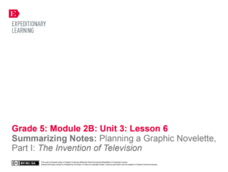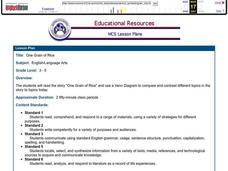EngageNY
Summarizing Notes: Planning a Graphic Novelette Part 1: The Invention of Television
What's the story? Learners create the first of four storyboards about the invention of the television, incorporating narrative techniques and descriptive details. Next, they offer and receive feedback by participating in a peer critique...
Curated OER
In Touch with Apples
Students read "How To Make an Apple Pie and See the World", the story of a girl who traveled the world to find the ingredients to make her apple pie. They conduct a series of interdisciplinary activities including testing their senses,...
Curated OER
One Grain of Rice
Upper graders read the story One Grain of Rice, and use a Venn diagram to compare and contrast topics found in the story to current event topics today. Groups of three learners work together to create their diagram. The topics they must...
Curated OER
The Power of One
High schoolers examine the origins of the Canadian nation and government. They study the principles upon which each of the provinces was founded. The four-lesson sequence also provides opportunities for experiences in visual art, story...
Curated OER
Cloze Instruction
Bring Goldilocks and the Three Bears, Mad Libs, and cloze activities to your college class with this lesson. They complete a cloze instruction activity in which the students choose words that would fill in the blanks and create their own...
Curated OER
Good Apples
Students investigate diversity. In this diversity lesson, students look at a variety of apples in order to compare and contrast their physical characteristics. They apply the concept to people by listing how people are the same and...
University of Arizona
Fusing Firecrackers with Narrative
Improve your youngsters' descriptive writing. They study an object and write about what they see as a warm-up, then they read an excerpt from Paul Guest's memoir, One More Theory about Happiness. The next part of the activity prompts...
Utah Education Network (UEN)
7th Grade Poetry: I Am Poem
A study of Alfred Noyes's poem "The Highwayman" opens a lesson about narrative poetry. Scholars read the poem and compare it to the animated video version using a worksheet. Learners look at models and use a template to craft an "I Am"...
EngageNY
Understanding Themes in Esperanza Rising
Determining a theme or central idea is greatly emphasized in the Common Core standards. Target that skill though big metaphors and central symbols in Pam Muñoz Ryan's Esperanza Rising. Help your class reach the standard through...
San Francisco Symphony
Learning Adjectives through the Duke
Duke Ellington, jazz, and jive kick-off a fun and creative lesson on responding emotionally to music. The class will learn about jive talk used in the 1920s and the life and music of Duke Ellington. They'll listen to a selection of his...
San Francisco Symphony
Going West
Now this sounds like a fun lesson! Youngsters learn about pioneer life and the Westward Movement. First, they listen to the Copland's "Appalachian Spring," and then they discuss the elements of music found in the piece. They get into...
PBS
Copyright and Fair Use
When is using someone else's copyrighted material appropriate? Learn about copyright and fair use with a lesson from PBS.org. Scholars read through a reference sheet about authors' rights and users' rights, and then create posters for a...
Curated OER
Christmas Candy
Here is a tasty topic for a lesson: Christmas candy! Third and fourth graders research classic Christmas candies, then create their very own! They write a descriptive paragraph about their candy, then use KidPix to create an illustration...
Core Knowledge Foundation
Isn’t It Exciting? (The American Industrial Revolution and Urbanization)
America was built on the ingenuity, work ethic, and foresight of our ancestors. Sixth graders learn about the complex Gilded Age in American history, including the prominent inventors and captains of industry, and how they all connect...
Curated OER
The White Stuff: Winter in Canada
Canadian winters, and its residents ways of dealing with winter are the focus of this four-lesson sequence. It them, high schoolers create works of art that reflect their perceptions of winter. They study how Canadian's have incorporated...
Curated OER
Talking Heads
After processing notes from research or an interview, middle schoolers turn the information into a script or dialogue for narrative, persuasive, or expository text. Use this lesson in any writing unit to reinforce proper writing skills.
Curated OER
Poetic Elements
Poetry is all about sound and rhythm. The sound of the words, the rhythm of the lines, and the emotional atmosphere created by these elements and the literary devices poets use, compress whole stories into a few stanzas. The specialized...
Curated OER
What Happened Next?
Fifth graders read one short story on their own. After reading, they are given a series of sentences and events from the short story and put them into the correct sequence. To end the lesson, they draw pictures from the story and...
Curated OER
Minnie and Moo and the Thanksgiving Tree
Third graders practice retelling stories. They read a story and work with a partner to discuss the key elements: characters, setting, events, beginning, and end. They assess one another as they retell the story. They rewrite the story in...
Curated OER
Time to Sleep
Students develop vocabulary and retell a story that they have just listened to.
Curated OER
The Artist As Storyteller
Students practice the art of storytelling by examining scroll writing techniques of Asia and applying them to a monthly story of their own classroom. This lesson is in two parts (Part II continues throughout the school year).
Curated OER
The Time I Got Lost
Third graders go through the writing process but substitute paper and pencil with the computer to create a story about "The Time I Got Lost".
Curated OER
Building a House
Students investigate the house building process by naming building materials and sequencing the steps.
Curated OER
Recreating Storyline
Seventh graders engage in a lesson that focuses on the sequence of a story and they discover its importance in the context of improving reading comprehension. Students analyze the plot of a story and reconstruct it into the right order.

























